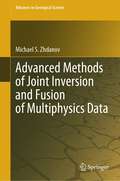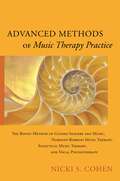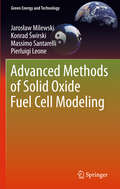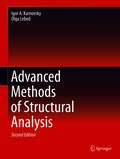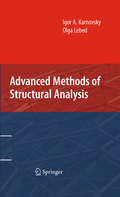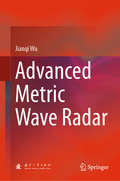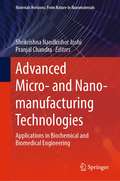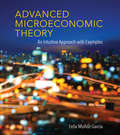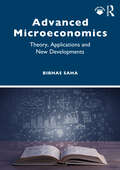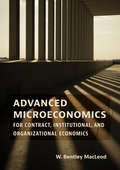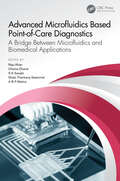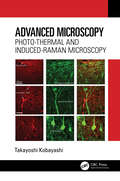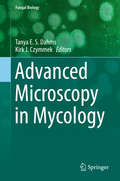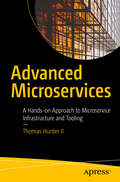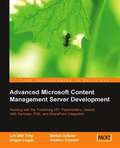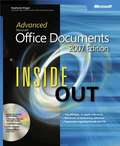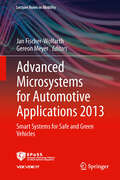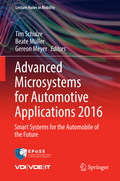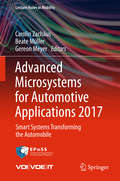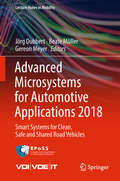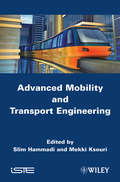- Table View
- List View
Advanced Methods of Joint Inversion and Fusion of Multiphysics Data (Advances in Geological Science)
by Michael S. ZhdanovDifferent physical or geophysical methods provide information about distinctive physical properties of the objects, e.g., rock formations and mineralization. In many cases, this information is mutually complementary, which makes it natural for consideration in a joint inversion of the multiphysics data. Inversion of the observed data for a particular experiment is subject to considerable uncertainty and ambiguity. One productive approach to reducing uncertainty is to invert several types of data jointly. Nonuniqueness can also be reduced by incorporating additional information derived from available a priori knowledge about the target to reduce the search space for the solution. This additional information can be incorporated in the form of a joint inversion of multiphysics data.Generally established joint inversion methods, however, are inadequate for incorporating typical physical or geological complexity. For example, analytic, empirical, or statistical correlations between different physical properties may exist for only part of the model, and their specific form may be unknown. Features or structures that are present in the data of one physical method may not be present in the data generated by another physical method or may not be equally resolvable.This book presents and illustrates several advanced, new approaches to joint inversion and data fusion, which do not require a priori knowledge of specific empirical or statistical relationships between the different model parameters or their attributes. These approaches include the following novel methods, among others: 1) the Gramian method, which enforces the correlation between different parameters; 2) joint total variation functional or joint focusing stabilizers, e.g., minimum support and minimum gradient support constraints; 3) data fusion employing a joint minimum entropy stabilizer, which yields the simplest multiphysics solution that fits the multi-modal data. In addition, the book describes the principles of using artificial intelligence (AI) in solving multiphysics inverse problems. The book also presents in detail both the mathematical principles of these advanced approaches to joint inversion of multiphysics data and successful case histories of regional-scale and deposit-scale geophysical studies to illustrate their indicated advantages.
Advanced Methods of Music Therapy Practice: Analytical Music Therapy, The Bonny Method of Guided Imagery and Music, Nordoff-Robbins Music Therapy, and Vocal Psychotherapy
by Nicki S. CohenAnalytical Music Therapy, The Bonny Method of Guided Imagery and Music, Nordoff-Robbins Music Therapy, and Vocal Psychotherapy are commonly studied and in conjunction with music therapy. This book examines the development of these four advanced methods of music therapy practice in relation to each other, and explores their impact on the development of the music therapy profession. Based on extensive new research and interviews with leading practitioners of the advanced methods, the book describes the differences, similarities, relationships, and trends between them, compares linearly the development of the music therapy profession primarily in the 20th century with the development of the four advanced methods, and speculates on the future of these advanced methods in relation to the future of music therapy as a profession.
Advanced Methods of Solid Oxide Fuel Cell Modeling (Green Energy and Technology)
by Jarosław Milewski Pierluigi Leone Massimo Santarelli Konrad ŚwirskiFuel cells are widely regarded as the future of the power and transportation industries. Intensive research in this area now requires new methods of fuel cell operation modeling and cell design. Typical mathematical models are based on the physical process description of fuel cells and require a detailed knowledge of the microscopic properties that govern both chemical and electrochemical reactions. Advanced Methods of Solid Oxide Fuel Cell Modeling proposes the alternative methodology of generalized artificial neural networks (ANN) solid oxide fuel cell (SOFC) modeling. Advanced Methods of Solid Oxide Fuel Cell Modeling provides a comprehensive description of modern fuel cell theory and a guide to the mathematical modeling of SOFCs, with particular emphasis on the use of ANNs. Up to now, most of the equations involved in SOFC models have required the addition of numerous factors that are difficult to determine. The artificial neural network (ANN) can be applied to simulate an object's behavior without an algorithmic solution, merely by utilizing available experimental data. The ANN methodology discussed in Advanced Methods of Solid Oxide Fuel Cell Modeling can be used by both researchers and professionals to optimize SOFC design. Readers will have access to detailed material on universal fuel cell modeling and design process optimization, and will also be able to discover comprehensive information on fuel cells and artificial intelligence theory.
Advanced Methods of Structural Analysis
by Igor A. Karnovsky Olga LebedThis revised and significantly expanded edition contains a rigorous examination of key concepts, new chapters and discussions within existing chapters, and added reference materials in the appendix, while retaining its classroom-tested approach to helping readers navigate through the deep ideas, vast collection of the fundamental methods of structural analysis. The authors show how to undertake the numerous analytical methods used in structural analysis by focusing on the principal concepts, detailed procedures and results, as well as taking into account the advantages and disadvantages of each method and sphere of their effective application. The end result is a guide to mastering the many intricacies of the range of methods of structural analysis. The book differentiates itself by focusing on extended analysis of beams, plane and spatial trusses, frames, arches, cables and combined structures; extensive application of influence lines for analysis of structures; simple and effective procedures for computation of deflections; introduction to plastic analysis, stability, and free and forced vibration analysis, as well as some special topics. Ten years ago, Professor Igor A. Karnovsky and Olga Lebed crafted a must-read book. Now fully updated, expanded, and titled Advanced Methods of Structural Analysis (Strength, Stability, Vibration), the book is ideal for instructors, civil and structural engineers, as well as researches and graduate and post graduate students with an interest in perfecting structural analysis.
Advanced Methods of Structural Analysis
by Olga Lebed Igor A. KarnovskyAdvanced Methods of Structural Analysis aims to help its readers navigate through the vast field of structural analysis. The book aims to help its readers master the numerous methods used in structural analysis by focusing on the principal concepts, as well as the advantages and disadvantages of each method. The end result is a guide to mastering the many intricacies of the plethora of methods of structural analysis. The book differentiates itself from other volumes in the field by focusing on the following: * Extended analysis of beams, trusses, frames, arches and cables * Extensive application of influence lines for analysis of structures * Simple and effective procedures for computation of deflections * Introduction to plastic analysis, stability, and free vibration analysis Authors Igor A. Karnovsky and Olga Lebed have crafted a must-read book for civil and structural engineers, as well as researches and students with an interest in perfecting structural analysis. Advanced Methods of Structural Analysis also offers numerous example problems, accompanied by detailed solutions and discussion of the results.
Advanced Metric Wave Radar
by Jianqi WuThis book systematically describes advanced metric wave radar and its practical applications, offering a comprehensive introduction to the engineering design methods from the perspectives of system design, antenna/feed and transmit/receive subsystems, as well as mechanical structure design. Focusing on the height-finding method, it describes in detail how the super-resolution technique can be used to solve the problem of low-angle height finding in metric wave radar. It also discusses the anti-jamming method for the unique jamming environment. Further, it presents narrowband target recognition methods to overcome the limitations of narrow absolute bandwidth in metric wave radar and to further explore the technique’s potential. Cooperative detection for metric wave radar netting is also addressed, and the main experimental results are included. The book offers a valuable resource for professional engineers, researchers and teachers, as well as graduate students engaged in radar system engineering, electronic engineering, and signal processing.
Advanced Micro- and Nano-manufacturing Technologies: Applications in Biochemical and Biomedical Engineering (Materials Horizons: From Nature to Nanomaterials)
by Shrikrishna Nandkishor Joshi Pranjal ChandraThis volume focuses on the fundamentals and advancements in micro and nanomanufacturing technologies applied in the biomedical and biochemical domain. The contents of this volume provide comprehensive coverage of the physical principles of advanced manufacturing technologies and the know-how of their applications in the fabrication of biomedical devices and systems. The book begins by documenting the journey of miniaturization and micro-and nano-fabrication. It then delves into the fundamentals of various advanced technologies such as micro-wire moulding, 3D printing, lithography, imprinting, direct laser machining, and laser-induced plasma-assisted machining. It also covers laser-based technologies which are a promising option due to their flexibility, ease in control and application, high precision, and availability. These technologies can be employed to process several materials such as glass, polymers: polycarbonate, polydimethylsiloxane, polymethylmethacrylate, and metals such as stainless steel, which are commonly used in the fabrication of biomedical devices, such as microfluidic technology, optical and fiber-optic sensors, and electro-chemical bio-sensors. It also discusses advancements in various MEMS/NEMS based technologies and their applications in energy conversion and storage devices. The chapters are written by experts from the fields of micro- and nano-manufacturing, materials engineering, nano-biotechnology, and end-users such as clinicians, engineers, academicians of interdisciplinary background. This book will be a useful guide for academia and industry alike.
Advanced Micro-Level Experimental Techniques for Food Drying and Processing Applications (Advances in Drying Science and Technology)
by Azharul Karim Sabrina Fawzia Mohammad Mahbubur RahmanAlthough strides have been made to quantitatively explore micro-level structural changes during food processing using advanced technologies, there is currently no comprehensive book that details these developments. Therefore, the research community and related industries are not fully aware of the available techniques. Advanced Micro-Level Experimental Techniques for Food Drying and Processing Applications fills this gap. The book has been written based on the authors’ comprehensive knowledge and application of microimaging methods in the thermal processing of food. Features Describes the latest micro-level experimental methods primarily using microimaging techniques Presents detailed procedures of applying these techniques in food processing Highlights the current challenges of developing efficient and novel food processing systems Describes the fundamentals of water transport processes and associated morphological changes during thermal processing of food materials This book is written for researchers, chemical, food, and industrial engineers and advanced students seeking to solve problems of industrial food processing.
Advanced Microeconomic Theory: An Intuitive Approach with Examples
by Felix Munoz-GarciaAn introduction to advanced topics in microeconomics that emphasizes the intuition behind assumptions and results, providing examples that show how to apply theory to practice.This textbook offers an introduction to advanced microeconomic theory that emphasizes the intuition behind mathematical assumptions, providing step-by-step examples that show how to apply theoretical models. It covers standard topics such as preference relations, demand theory and applications, producer theory, choice under uncertainty, partial and general equilibrium, monopoly, game theory and imperfect competition, externalities and public goods, and contract theory; but its intuitive and application-oriented approach provides students with a bridge to more technical topics. The book can be used by advanced undergraduates as well as Masters students in economics, finance, and public policy, and by PhD students in programs with an applied focus.The text connects each topic with recent findings in behavioral and experimental economics, and discusses these results in context, within the appropriate chapter. Step-by-step examples appear immediately after the main theoretical findings, and end-of chapter exercises help students understand how to approach similar exercises on their own. An appendix reviews basic mathematical concepts. A separate workbook, Practice Exercises for Advanced Microeconomic Theory, offers solutions to selected problems with detailed explanations. The textbook and workbook together help students improve both their theoretical and practical preparation in advanced microeconomics.
Advanced Microeconomics: Theory, Applications and New Developments
by Bibhas SahaAdvanced Microeconomics presents microeconomic problems in an intuitive way. Using lucid narratives to build on students’ initial understanding of economics and economic reality, equations and diagrams are incorporated to provide accessibility to students with a basic level of calculus to reach precise quantitative answers. It covers the standard areas of microeconomics such as consumer theory, producer theory, economics of uncertainty, general equilibrium and markets.The book also includes new developments such as behavioural economics, prospect and regret theory, public-sector firms, bargaining, signalling games, adverse selection and moral hazard. Real-life applications are given throughout the chapters, clearly showing students how the advanced theory connects to the real world. Each chapter provides a set of exercises for independent problem-solving. Learning is also supported by lists of key terms, chapter summaries and further reading suggestions. Advanced technical materials are presented in optional appendices. Digital supplements include quiz questions, solutions to exercises and instructor materials. The flexible chapter sequencing in the book enables instructors to create their preferred syllabus.Developing students’ intuitive appreciation for the theory as well as mathematical analysis, this is the ideal textbook for microeconomics courses at master’s level (MSc and MRes) and advanced undergraduate level.
Advanced Microeconomics for Contract, Institutional, and Organizational Economics
by W. Bentley MacLeodA graduate textbook on microeconomics, covering decision theory, game theory, and the foundations of contract theory, with a unique focus on the empirical.This graduate-level text on microeconomics, covering such topics as decision theory, game theory, bargaining theory, contract theory, trade under asymmetric information, and relational contract theory, is unique in its emphasis on the interplay between theory and evidence. It reviews the microeconomic theory of exchange &“from the ground up,&” aiming to produce a set of models and hypotheses amenable to empirical exploration, with particular focus on models that are useful for the study of contracts, institutions, and organizations. It explores research that extends price theory to the exchange of commodities when markets are incomplete, discussing recent developments in the field. Topics covered include the relationship between theory and evidence; decision theory as it is used in contract theory and institutional design; game theory; axiomatic and strategic bargaining theory; agency theory and the class of models that are considered to constitute contract theory, with discussions of moral hazard and trade with asymmetric information; and the theory of relational contracts. The final chapter offers a nontechnical review that provides a guide to which model is the most appropriate for a particular application. End-of-chapter exercises help students expand their understanding of the material, and an appendix provides brief introduction to optimization theory and the welfare theorem of general equilibrium theory. Students are assumed to be familiar with general equilibrium theory and basic constrained optimization theory.
Advanced Microfluidics Based Point-of-Care Diagnostics: A Bridge Between Microfluidics and Biomedical Applications
by Raju Khan, Chetna Dhand, S. K. Sanghi, Shabi Thankaraj Salammal, and A. B. P. MishraThis book provides a well-focused and comprehensive overview of novel technologies involved in advanced microfluidics based diagnosis via various types of prognostic and diagnostic biomarkers. This authors examine microfluidics based diagnosis in the biomedical field as an upcoming field with extensive applications. It provides a unique approach and comprehensive technology overview for diagnosis management towards early stages of various bioanalytes via cancer diagnostics diabetes, alzheimer disease, toxicity in food products, brain and retinal diseases, cardiovascular diseases, and bacterial infections etc. Thus, this book would encompass a combinatorial approach of medical science, engineering and biomedical technology. The authors provide a well-focused and comprehensive overview of novel technologies involved in advanced microfluidics based diagnosis via various types of prognostic and diagnostic biomarkers. Moreover, this book contains detailed description on the diagnosis of novel techniques. This book would serve as a guide for students, scientists, researchers, and microfluidics based point of care technologies via smart diagnostics and to plan future research in this valuable field.
Advanced Microscopy: Photo-Thermal and Induced-Raman Microscopy
by Takayoshi KobayashiThis book covers the principle, structure, enhancement of sensitivity and resolution power of photothermal and Raman microscopies. It includes real-world applications to biological and medical targets.Advanced Microscopy: Photo-Thermal and Induced-Raman Microscopy introduces clear descriptions of various Raman processes such as spontaneous, stimulates, coherent anti-Stokes Raman (CARS), Raman loss and Stokes Raman (gain). It covers pump-probe microscopies using actinic (pump) laser and sensing (probe) laser resulting in improvement due to intrinsic nonlinearity, which provides an advantage in the imaging of nonfluorescent targets. The author also provides solutions to noise and sensitivity problems which are two of the most important concerns in the microscopy applications. Finally, the book also draws direct comparisons of the advantages and drawbacks of a Raman microscopes in comparison with photothermal microscopes.The book will be useful to researchers and non-specialists in biomedical fields using optics and electronics relevant to (optical) microscopes. It will also be a helpful resource to graduate students in the fields of biology and medical research who are using photothermal microscopes in their research.
Advanced Microscopy in Mycology (Fungal Biology)
by Tanya E. S. Dahms Kirk J. CzymmekThe aim of this volume is to describe the latest advances in microscopic methods, including integrated techniques, as applied to mycology. Each chapter will provide a brief overview of a particular microscopic method with associated advantages and limitations, the research questions that can be appropriately addressed using these microscopic methods, how it has been successfully applied to address mycological research questions, including supporting and complimentary techniques, and which future questions can be addressed.
Advanced Microservices: A Hands-on Approach to Microservice Infrastructure and Tooling
by Thomas Hunter IIUse the many types of tools required to navigate and maintain a microservice ecosystem. This book examines what is normally a complex system of interconnected services and clarifies them one at a time, first examining theoretical requirements then looking at concrete tools, configuration, and workflows. Building out these systems includes many concerns such as containerization, container orchestration, build pipelines and continuous integration solutions, automated testing, service discovery, logging and analytics. You will examine each of these tools and understand how they can be combined within an organization. You will design an automated build pipeline from Pull Request to container deployment, understand how to achieve High Availability and monitor application health with Service Discovery, and learn how to collaborate with other teams, write documentation, and describe bugs. Covering use of Jenkins, Docker, Kubernetes, the ELK stack (Elasticsearch, Logstash, and Kibana), and StatsD and Grafana for analytics, you will build on your existing knowledge of Service-Oriented Architecture and gain an advanced, practical understanding of everything from infrastructure development to team collaboration. What You'll Learn Design an API to be convenient for developers to consume. Deploy dynamic instances of Microservices and allow then to discover each other. Track the health of a Microservice and be notified in case of degraded performance. Write effective documentation and communicate efficiently with other teams. Who This Book Is For Those who would like a better understanding of System Oriented Architecture. Those who would like to break a monolith into smaller Microservices. Those who are familiar with Microservices and would like a better understanding of peripheral technologies.
Advanced Microsoft Content Management Server Development
by Angus Logan Andrew ConnellThis book is written for developers who want to the skills to fully exploit the power of MCMS and SPS. The book presumes a working knowledge of MCMS, the .NET Framework and familiarity with the C# language. All the code examples are in C#.
Advanced Microsoft® Office Documents 2007 Edition Inside Out
by Stephanie Krieger<div xmlns="http://www.w3.org/1999/xhtml"><p>Learn how to create dynamic documents with impact by using the 2007 Microsoft Office system from the inside out! This book packs hundreds of time-saving solutions, troubleshooting tips, and workarounds, all in concise, fast-answer format.</p></div>
Advanced Microsoft® Office Documents 2007 Edition Inside Out
by Stephanie KriegerDig deep into Microsoft Office Word 2007, Excel2007, and PowerPoint 2007--and create robust documents that deliver results. This book is packed with advanced timesaving tips and troubleshooting methods to help you learn the smartest, simplest ways to create powerful documents. Discover how the experts approach document production--and reach new levels of mastery! Exploit the power of tables, Themes, and templates Produce professional-quality graphics using new SmartArt diagrams, custom shapes, and other drawing tools Customize and reuse content with Building Blocks and Content Controls Learn advanced techniques for managing slide masters and custom layouts for effective presentations Design PivotTables for more powerful data analysis and reporting Build sophisticated Excel 2007 chart types and customize chart elements Use Microsoft Visual Basic for Applications (VBA) to automate document production and customize templates Customize the Office Fluent Ribbon and troubleshoot your documents with Office Open XML CD includes: Fully searchable eBook Sample documents and templates VBA and Office Open XML code samples Author webcasts--see advanced techniques in action Tool for binding custom XML to content controls in Word 2007 Files for customizing the Fluent Ribbon Links to articles blogs, and developer learning resources Windows Vista Product Guide eReference and other eBooks A Note Regarding the CD or DVD The print version of this book ships with a CD or DVD. For those customers purchasing one of the digital formats in which this book is available, we are pleased to offer the CD/DVD content as a free download via O'Reilly Media's Digital Distribution services. To download this content, please visit O'Reilly's web site, search for the title of this book to find its catalog page, and click on the link below the cover image (Examples, Companion Content, or Practice Files). Note that while we provide as much of the media content as we are able via free download, we are sometimes limited by licensing restrictions. Please direct any questions or concerns to booktech@oreilly.com.
Advanced Microsoft Word Windows Vista: Desktop Publishing 2007
by Joanne ArfordThis text is designed for the student to complete projects and assessments on a computer running a standard installation of Microsoft Office 2007, Professional Edition, and the Microsoft Windows Vista operating system.
Advanced Microsystems for Automotive Applications 2013: Smart Systems for Safe and Green Vehicles (Lecture Notes in Mobility)
by Gereon Meyer Jan Fischer-WolfarthThe road vehicle of the future will embrace innovations from three major automotive technology fields: driver assistance systems, vehicle networking and alternative propulsion. Smart systems such as adaptive ICT components and MEMS devices, novel network architectures, integrated sensor systems, intelligent interfaces and functional materials form the basis of these features and permit their successful and synergetic integration. They increasingly appear to be the key enabling technologies for safe and green road mobility. For more than fifteen years the International Forum on Advanced Microsystems for Automotive Applications (AMAA) has been successful in detecting novel trends and in discussing the technological implications from early on. The topic of the AMAA 2013 will be "Smart Systems for Safe and Green Vehicles". This book contains peer-reviewed papers written by leading engineers and researchers which all address the ongoing research and novel developments in the field. www.amaa.de
Advanced Microsystems for Automotive Applications 2015: Smart Systems for Green and Automated Driving (Lecture Notes in Mobility)
by Gereon Meyer Beate Müller Tim SchulzeThis edited volume presents the proceedings of the AMAA 2015 conference, Berlin, Germany. The topical focus of the 2015 conference lies on smart systems for green and automated driving. The automobile of the future has to respond to two major trends, the electrification of the drivetrain, and the automation of the transportation system. These trends will not only lead to greener and safer driving but re-define the concept of the car completely, particularly if they interact with each other in a synergetic way as for autonomous parking and charging, self-driving shuttles or mobile robots. Key functionalities like environment perception are enabled by electronic components and systems, sensors and actuators, communication nodes, cognitive systems and smart systems integration. The book will be a valuable read for research experts and professionals in the automotive industry but the book may also be beneficial for graduate students.
Advanced Microsystems for Automotive Applications 2016: Smart Systems for the Automobile of the Future (Lecture Notes in Mobility)
by Gereon Meyer Beate Müller Tim SchulzeThis edited volume presents the proceedings of the AMAA 2015 conference, Berlin, Germany. The topical focus of the 2015 conference lies on smart systems for green and automated driving. The automobile of the future has to respond to two major trends, the electrification of the drivetrain, and the automation of the transportation system. These trends will not only lead to greener and safer driving but re-define the concept of the car completely, particularly if they interact with each other in a synergetic way as for autonomous parking and charging, self-driving shuttles or mobile robots. Key functionalities like environment perception are enabled by electronic components and systems, sensors and actuators, communication nodes, cognitive systems and smart systems integration. The book will be a valuable read for research experts and professionals in the automotive industry but the book may also be beneficial for graduate students.
Advanced Microsystems for Automotive Applications 2017: Smart Systems Transforming the Automobile (Lecture Notes in Mobility)
by Gereon Meyer Beate Müller Carolin ZachäusThis volume of the Lecture Notes in Mobility series contains papers written by speakers and poster presenters at the 21st International Forum on Advanced Microsystems for Automotive Applications (AMAA 2017) "Smart Systems Transforming the Automobile" that was held in Berlin, Germany in September 2017. The authors report about recent breakthroughs in electric and electronic components and systems, driver assistance and vehicle automation as well as safety and testing. Furthermore, legal aspects and impacts of connected and automated driving are covered. The target audience primarily comprises research experts and practitioners in industry and academia, but the book may also be beneficial for graduate students alike.
Advanced Microsystems for Automotive Applications 2018: Smart Systems for Clean, Safe and Shared Road Vehicles (Lecture Notes in Mobility)
by Jörg Dubbert Beate Müller Gereon MeyerThis volume of the Lecture Notes in Mobility series contains papers written by speakers at the 22nd International Forum on Advanced Microsystems for Automotive Applications (AMAA 2018) "Smart Systems for Clean, Safe and Shared Road Vehicles" that was held in Berlin, Germany in September 2018. The authors report about recent breakthroughs in electric and electronic components and systems, driver assistance, vehicle automation and electrification as well as data, clouds and machine learning. Furthermore, innovation aspects and impacts of connected and automated driving are covered. The target audience primarily comprises research experts and practitioners in industry and academia, but the book may also be beneficial for graduate students alike.
Advanced Mobility and Transport Engineering
by Slim Hammadi Mekki KsouriMultimodal transport network customers need to be directed during their travels. A travel support tool can be offered by a Multimodal Information System (MIS), which allows them to input their needs and provides them with the appropriate responses to improve their travel conditions. The goal of this book is to design and develop methodologies in order to realize a MIS tool which can ensure permanent multimodal information availability before and during travel, considering passengers’ mobility. The authors propose methods and tools that help transport network customers to formulate their requests when they connect to their favorite information systems through PC, laptop, cell phone, Portable Digital Assistant (PDA), etc. The MIS must automatically identify the websites concerning the customer’s services. These sites can, in fact, represent transport services, cultural services, tourist services, etc. The system should then be able to collect the necessary travel information from these sites in order to construct and propose the most convenient information according to the user’s requests. Contents 1. Agent-oriented Road Traffic Simulation, René Mandiau, Sylvain Piechowiak, Arnaud Doniec and Stéphane Espié. 2. An Agent-based Information System for Searching and Creating Mobility-aiding Services, Slim Hammadi and Hayfa Zgaya. 3. Inter-vehicle Services and Communication, Sylvain Lecomte, Thierry Delot and Mikael Desertot. 4. Modeling and Control of Traffic Flow, Daniel Jolly, Boumediene Kamel and Amar Benasser. 5. Criteria and Methods for Interactive System Evaluation: Application to a Regulation Post in the Transport Domain, Houcine Ezzedine, Abdelwaheb Trabelsi, Chi Dung Tran and Christophe Kolski.
